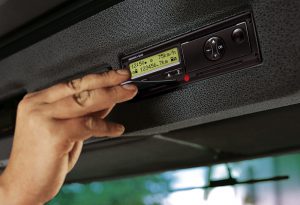
Digital Tachograph Rules Made Easy
- Blog
- Transportation
- Digital Tachograph Rules Made Easy
- Apr 03, 2018
- Cody Lirette
For both HGV drivers and O-licence operators, a lack of knowledge about digital tachograph rules is unlikely to be sufficient as an excuse for non-compliance.
That’s not to suggest that tachograph rules are easy to understand. They certainly are difficult to take in at first glance; the full text of the EU tachograph rules can be found here. To make it even more complicated, drivers are also bound by the Road Transport (Working Time) Regulations of 2005.
So we have decided to assemble a brief guide to the most important aspects of these tachograph rules for drivers and truck fleet staff – but do rely on the full rules when making decisions. Here we go:
1) Tachograph Rules – Maximum Driving Hours
The daily maximum driving hours is set to 9 hours but this can be exceeded to 10 hours twice each week.
The weekly maximum driving hours can total no more than 56 hours, and the maximum two-weekly driving limit is 90 hours over any 2 week period.
2) Tachograph Rules – Breaks
The driver must take at least 45 minutes of breaks every 4.5 hours of driving unless he takes a rest period. This may be a single 45-minute break, or a single 15-minute break followed by a single 30-minute break.
3) Tachograph Rules – Minimum Rest Each Day
A driver must be given at least 11 consecutive hours of rest each day. If a vehicle is equipped with a compliant bunk, some or all of this rest may be taken in the vehicle if it is stationary.
Alternatively, the rest period may be split into two periods, one of at least 3 hours followed by another of at least 9 hours.
Up to 3 times each week, this daily rest may be curtailed to only 9 hours in total.
All daily rests must be completed within 24 hours of the end of the previous daily or weekly rest.
A daily rest period may be taken on a train or ferry journey of not less than 11 hours, but it may be interrupted not more than twice by activities not exceeding a total of one hour. The driver must have access to a couchette or bunk for the entire period.
If double-manning, a driver must take a new daily rest of not less than 9 hours within 30 hours of the end of the last daily or weekly rest period. The presence of the back-up driver is only optional for the first hour of driving; after that, it is compulsory.
4) Tachograph Rules – Minimum Rest Each Week
Each week, a driver must be given a rest of at least 45 (regular weekly rest) or 24 hours (reduced weekly rest). This must begin no later than the end of 6 consecutive 24-hour days from the end of that driver’s last weekly rest. In any 2-week period, a driver must get at least one 45 hour rest and one 24 hour rest. A rest that stretches across two 1-week periods may be counted towards either week, but not both.
Any reductions in weekly rest must be compensated for by adding the missed hours to another rest block (which started at no less than 9 hours) and must be given before the end of the third week.
5) Non-Tachograph Rules – Additional Requirements of the Road Transport Regulations
- Maximum working time cannot exceed 60 hours in a single week and must average no more than 48 hours per week.
- Night work cannot occupy more than 10 hours of every 24 unless a collective workforce agreement is in place.
- Breaks must take place at least every 6 consecutive hours -30 minutes for 6 hours or 45 minutes for 9, and taken in increments of no less than 15 minutes each.
- Records must be kept for 2 weeks after the end of each designated period.
Read more on Tachograph Rules: What European drivers and Hauliers Need to Know.
Visit our Tachograph Management page to learn more about our Tacho products or email us at sales@orbcomm.com.

Cody Lirette is Senior Content Marketing Manager at ORBCOMM. With over a decade of marketing and communications experience for both the public and private sector, he uses his passion for innovative technology and plain language to build compelling content that inspires action.


















